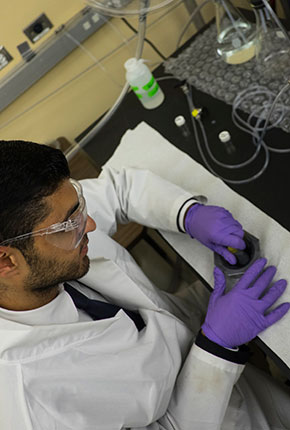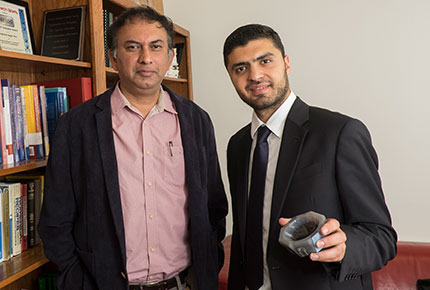Eureka!
LAU part of a scientific research that is set to push new frontiers in technology.
Together with a team of experts, LAU professor of chemistry Ahmad Kabbani and LAU alumnus and Ph.D. student at Rice University Mohamad Kabbani have been significant contributors to a groundbreaking research that has the potential to revolutionize the use of electronic devices, including computers and medical devices.
The results of the research, published in leading science journal Nature, are seen as heralding a turning point in the field of nanotechnology. “This is a milestone that will pave the way for more accomplishments to come,” says Kabbani.
The breakthrough came in 2012, when Kabbani was taking his sabbatical at Rice University in Houston, Texas. His son Mohammad was conducting experiments using carbon nanotubes — which appear as thin black powder – in the laboratories of Professor Pullickel Ajayan. “We ground two carbon nanotubes (CNTs) of different functionalities in the solid state and saw that doing so produced a silver sheet,” Kabbani recollects. “I could not believe this could really be graphene.”
Viable graphene has been the elusive goal of more than two decades of intense scientific research. Scientists worldwide have tried to obtain graphene sheets by cutting open carbon nanotubes, which under a microscope have roughly the shape of a straw – by treating them with concentrated chemicals under very harsh conditions. The use of chemical components, combined with very high temperatures, always left the graphene sheets crumpled and reduced their electrical conductivity.
“Our method is very easy in comparison to the ones that were tried out before,” says Ahmad Kabbani while demonstrating the process. In a moment Kabbani likes to describe as “serendipity”, a flat silver sheet surfaces along the walls of the container where the two black powders have been manually ground. “This discovery will open the door for solid state experiments under ambient conditions,” he says.
Since 2012, Kabbani and his son, — with the support of LAU, the Brazil Institute of Theoretical Research, the US Army Force, a grant to Ajayan and funds from India – have worked hard to verify the validity of their claim through spectroscopic measurements, electron microscopy, thermal analysis and molecular dynamic simulations.
The next step will be using the graphene to produce a wafer, an ultra-thin layer of conductive material employed in the realization of microchips. Employing graphene – a hundred times more conductive than the presently used silicon – will raise the performance of electronic devices to unimaginable levels. Its higher thermal conductivity will also decrease the risk of device damage due to overheating and appreciably enhance the lifetime of electronic devices.
“I am extremely grateful to LAU for having supported this research and for allowing me to take a sabbatical year in the United States,”,says Kabbani. While working in the U.S. with an international team of experts, Mohammad Kabbani does not forget his origins.
“It gives me great pleasure to present myself as a Lebanese citizen who graduated from a top university like LAU,” he says. “It paved my way to where I am today.”
More
Latest Stories
- SOE Launches its Distinguished Scholar Visiting Program with International Guest Dr. Feras Batarseh
- LAU Nursing Camp Opens Eyes, Hearts and Futures
- Meet Dr. Zeina Khouri-Stevens, Executive Vice President for Health Services
- LAU Family Medicine Graduates to Benefit from a Partnership With Nova Scotia
- AKSOB Assistant Professor Shares Her Vision for the Future of Learning
- LAU Simulation Models Celebrate 20 Years of Learning, Leadership and Service
- The School of Engineering Hosts the Lebanese Electromagnetics Day
- LAU Stands Out on the Sustainability Scores



